GARDENS BY THE BAY
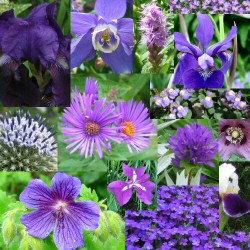
BOTANICAL LATIN
Botanical names are everywhere these days - in garden literature, on plant tags and most especially on the Internet.
Perhaps you're wondering why you need to bother with them at all. There are several reasons.
- it's fun and relatively easy to both learn and use botanical names
- botanical names are the same, all around the world (including on the Internet)
- common names differ widely from place to place
- a number of different common names may apply to a single plant but each plant has only one correct botanical name
- the best gardening books now list plants alphabetically by botanical names, with correct pronunciation
- botanical names reveal many plant, flower or leaf characteristics
Keep it simple on the start. Try to learn about each new plant as you add it to your collection. You may only want to know a few basics. If you wish to learn more, there are several good links below to take you to other sources of information on this subject. Be sure to bookmark us before you follow those links so you can find your way back here again.
I have a wonderful little reference book called "Gardener's Latin" by Bill Neal. Small in size but huge in information and botanical Latin terminology, it is an excellent addition to your library of garden-related books.
REMEMBER
Botanical Latin should be fun. When it seems like work, take a break and enjoy the numerous flower and garden images on this and other pages on our site. Our links immediately below and a full list at the bottom of this page will take you to many of our other pages about a variety of subjects including but not limited to:
For those ready to dip their toes into the waters of Botanical Latin, all you need to do is keep reading below.
A FEW SIMPLE RULES
GENDER
In Latin, as in many languages, every noun has a gender - masculine, feminine or neuter. Any adjectives that describe them must match that gender. They do so by using different endings. Generally the masculine ending is -um, the feminine ending is -a and the neuter ending is -us. So an adjective used to describe a white masculine noun will be album, to describe a white feminine noun will be alba, and to describe a white neuter noun will be albus.
Look at the three examples below to see the various masculine, feminine and neuter endings in use.
Of course, nothing is that simple and there are some different endings. Don't let them confuse you at this point. Simply learn new names as you encounter them. The two most notable exceptions are ruber (red) and niger (black).
Asarum europaeum
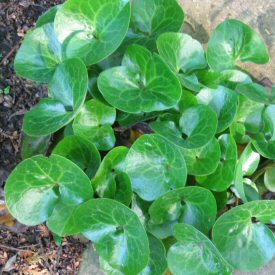
uh-sair´-um yure-oh-pee´-um
Echinacea purpurea alba: white Purple Coneflower
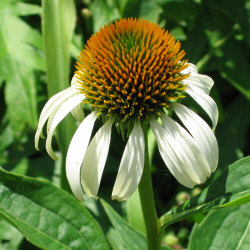
eh-kih-nay´-see-uh purr-pure´-ee-uh al´-buh
Dictamnus albus purpureus: Gas Plant
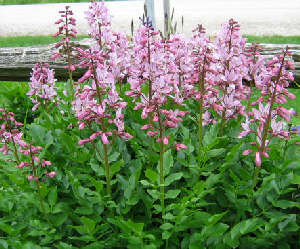
dick-tam´-nuss al´-bus purr-pure´-ee-us
VOWELS * * * this is essential
Each vowel must be in a separate syllable. The only exception is for diphthongs - two vowels which together produce a single sound. Diphthongs are ai, eu, oi and ou. Learn this basic rule before you proceed to other concepts to make learning much easier.
SYLLABLES
In order to pronounce a botanical term properly, you must first divide it into syllables. It is quite simple to do this, provided you remember the rule outlined above with regard to vowels. The examples above show how the botanical names for European Ginger, white Purple Coneflower and Gas Plant are divided into syllables, based on the one-vowel-per-syllable rule.
CONSONANTS - PRONUNCIATION
The consonants b, d, f, h, k, l, m, n, p, q, r, t, x and z are pronounced as in English.
And what about the remaining consonants - c, g, j, v and w? Here it would be helpful if you could think back to your Public School grammar lessons. The letters C and G are soft before the vowels e, i and y but hard before the vowels a, o and u.
HARD "C" EXAMPLES - sounding like "k"

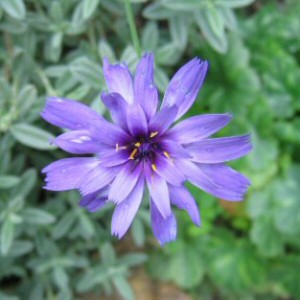
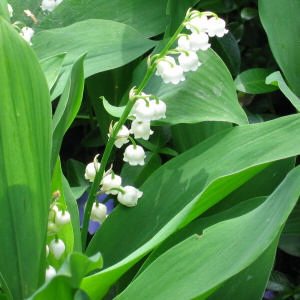
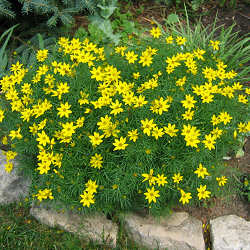
From left to right, they are:
- Campanula: Bellflower, Harebell - kam-pann´-yew-luh
- Catananche: Cupid's Dart - kat-uh-nan´-kee
- Convallaria: Lily-of-the-Valley - con-vah-lair´-ee-ah
- Coreopsis: Coreopsis, Tickseed - core-ee-op´-sis
Other examples include:
- Caltha: Marsh Marigold - kal´-thuh
- Caryopteris: Bluebeard - care-ee-op´-turr-us
- Codonopsis: Bonnet Bellflower - cod-on-op´-siss
- Corydalis: Corydalis - core-rid´-uh-liss
- Cupressus: Cypress - kew-press´-us
The "c" in the above examples is at the beginning of a word. It will also have a hard sound when it appears in front of a, o and u:
- within a word
- Acanthus - uh-kann´-thuss
- Aconitum - a-konn-eye´-tum
- within an epithet
- caucasica - kaw-kay´-sih-kuh
- cordifolia - core-dih-foe´-lee-uh
- dioicus - dye-oh´-ih-kuss
- divaricatus - die-vair-ih-kay´-tuss
- italicum - ih-tal´-ih-kum
- nudicaule - noo-dih-kaw´-lee
- pontica - ponn´-tih-kuh
- ptarmica - tarr´-mih-kuh
- pyrenaicum - peer-ih-nay´-ih-kum
- within a cultivar name
- 'Camelliard' - ka-mee´-lee-ard
- 'Compinkie' - kom-pin´-kee
SOFT "C" EXAMPLES - sounding like "s"
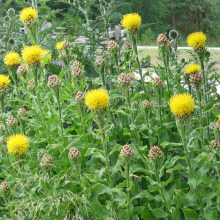

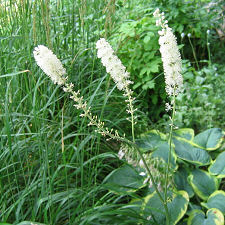
From left to right, they are:
- Centaurea: Cornflower - sen-tore´-ee-uh
- Ceratostigma: Leadwort - sir-rat-oh-stig´-muh
- Cimicifuga: Bugbane - sim-ih-siff´-yew-guh
Other examples include:
- Centranthus: Valerian, Jupiter's Beard - sen-tran´-thus
- Cerastium: Snow-In-Summer - sir-ass´-tee-um
- Cynara: Cardoon - sigh-narr´-uh
The "c" in the above examples is at the beginning of a word. It will also have a soft sound when it appears before e, i and y:
- within a word
- Alcea - al´-see-uh
- Dicentra - die-sen´-truh
- Hyacinthus - high-uh-sinn´-thus
- Sidalcea - sid-al´see-uh
- Tanacetum - tann-uh-see´tum
- within an epithet
- ludoviciana - loo-doe-vih-see-ay´-nuh
- margaritacea - mar-gar-ih-tay´-see-uh
- persicifolia - purr-sih-sih-foe´-lee-uh
- simplicifolia - simm-plih-sih-foe´-lee-uh
- within a cultivar name
- 'Citrinum' - sih-try´-num
- 'Hyacinthina' - high-uh-sinn-thigh´-nuh
HARD "G" EXAMPLES - sounding like "g"
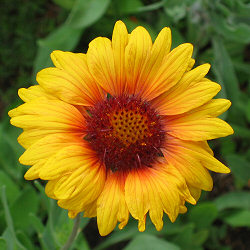
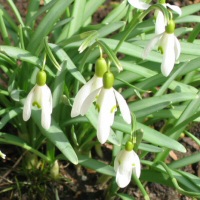
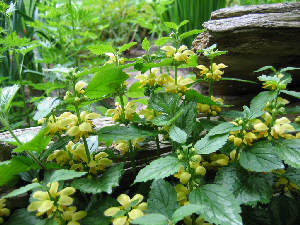
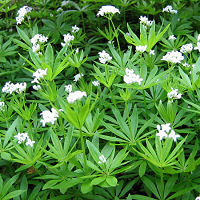
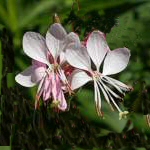
From left to right, they are:
- Gaillardia: Blanket Flower - gay-larr´-dee-uh
- Galanthus: Snowdrops - guh-lann´-thuss
- Galeobdolon: Yellow Archangel - gay-lee-ob´-duh-lonn
- Galium: Sweet Woodruff - gay´-lee-um
- Gaura: White Gaura - gaw´-ruh
Other examples include:
- Galega: Goat's Rue - gal´-eh-guh
- Galtonia: Summer Hyacinth - gall-toe´-nee-uh
- Gomphrena: Gomphrena - gomm-free´-nuh
- Gunnera: Giant Gunnera - gun´-nurr-uh
The "g" in the above examples is at the beginning of a word. It will also have a hard sound when it appears before a, o or u:
- within a word
- Chrysoganum - kriss-awg´-uh-num
- Cimicifuga - simm-ih-siff´-yew-guh
- Ligularia - lig-yew-lair´-ee-uh
- Ophiopogon - off-ee-oh-poe´-gon
- within an epithet
- angustifolia - ann-gust-ih-foe´-lee-uh
- garganica - gar-gann´-ih-kuh
- gigantea - jye-gann´-tee-uh
- margaritacea - mar-gar-ih-tay´-see-uh
- tangutica - tan-gew´-tih-kuh
- tongolensis - tonn-go-lenn´-siss
- within a cultivar name
- 'Guizho' - ghee´-zoe
- 'Variegata' - vair-ee-uh-gay´-tuh
SOFT "G" EXAMPLES - sounding like "j"

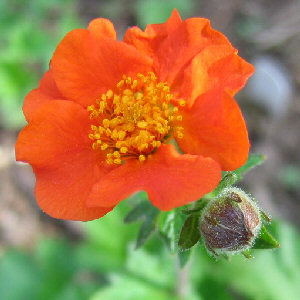
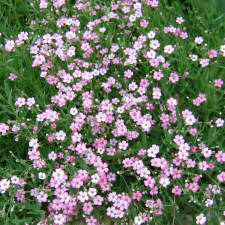
From left to right, they are:
- Geranium: Cranesbill - jerr-ray´-nee-um
- Geum: Avens - jee´-um
- Gypsophila: Baby's Breath - jipp-soff´-fill-uh
Other examples include:
- Genista: Broom - jen-niss´-tuh
- Gentiana: Gentian - jen-shee-aye´-nuh
- Gerbera: Gerbera Daisy - jerr´-burr-uh * often mis-pronounced with a hard "g" rather than the correct soft "g"
The "g" in the above examples is at the beginning of a word. It will also have a soft sound when it appears before e, i or y:
- within a word
- Bergenia - burr-jhee´-knee-uh
- Digitalis - dij-ih-tay´-liss
- Erigeron - ehr-ridge´-ur-on
- Eryngium - ee-rin´-jee-um
- within an epithet
- argentea - ahr-jen´-tee-uh
- novi-belgii - noh-veye-bell´-gee-eye
- plumbaginoides - plum-bah-gin-oh-eye´-deez
- rigescens - ridge-ess´-enz
- within a cultivar name
- 'Argenteus' - ahr-gent´-ee-us
- 'Aureo-Marginata' - or-ee-oh-mar-gin-ay´-tuh
TIP
The above information is more than enough to get you started. Always remember that you can learn as little or as much as you think you need for your purposes. After all, Aunt Martha's purple and white iris will probably not grow any better for your knowing its correct name is Iris x germanica 'Wabash' or its pronunciation is eye´-riss jerr-man´-ih-kuh.
FOR THOSE WHO WANT TO KNOW MORE
For easy reference, we've divided some simple words into categories and placed them in several tables below which include:
| COMMON ENDINGS |
|---|
| You will encounter the endings below repeatedly in your gardening experience so learn them first. |
| LATIN SUFFIX | PRONUNCIATION | EXAMPLES | PRONUNCIATION
|
| -ae | ee | novae-angliae | noe´vee - ann´glih-ee |
| -aeus, -aea, -aeum |
ee´-us, ee´-ah, ee´-um |
europaeum | yure-oh-pea´-um |
| -anus, -ana, -anum |
ay´nuss, ay´-nah, ay´-num |
americana | a-mair-ih-kay´nah |
| -aris | air´-iss | Phalaris | fill-air´-iss |
| -atus, -ata, -atum | ay´-tuss, ay´-tah, ay´tum |
divaricatus | dye-vair-ih-kay´tuss |
| -ea | ee-uh | Centaurea | senn-tore´-ee-ah |
| -ensis | enn´-siss | tongolensis | tawn-go-lenn´-siss |
| -eum, -ea, -eus |
ee-um, ee-ah, ee-us | caeruleum | see-rule´-ee-um |
| -ius, -ia, -ium | ee-us, ee-ah, ee-um | tenuifolia | tenn-yew-ih-foe´-lee-ah |
| -iae | ee-ee or ih-ee | juliae | you´lih-ee |
| -ii | ee-eye | jackmanii | jack-mann´-ee-eye |
| -inus, -ina, -inum | eye´-nuss, eye´nah, eye´num | alpinus | al-pine´uss |
| -ioides | ee-oh-eye´-deez | histrioides | hiss-tree-oh-eye´-deez |
| -oides | oh-eye-deez | clethroides | cleth-roe-eye´-deez |
| -uus, -ua, -uum | you-uss, you-ah, you-um |
cernuum | sir´-new-um |
| WORDS THAT REFER TO PLANT PARTS |
|---|
| These prefixes and suffixes can tell you much about a plant, its flowers, foliage or other parts. Learn them early on. |
| LATIN | PRONUNCIATION | MEANING | EXAMPLES |
| phyl- | fill | referring to a leaf | pol-y-phyl´-la - having multiple leaves |
| caul- | call | referring to a stem | cau-li-flo´-rus - having flowers on the stems |
| cocc- | cox | referring to a seed or berry | coc-ci´fer-a - having berries |
| coni- | konn-ih | referring to a cone | co-ni´fer-us - having cones |
| flor- | flore | referring to a flower | flo´-rid-a - free-flowering |
| foli- | foe-lee | referring to foliage | fo´li-us - leaved |
| frond- | frond | referring to a leaf | fron-do´sus - |
| misc- | misk | referring to a stem | misc-an´thus |
| nod- | graw | referring to a node | no-do´-sus - jointed, with joints or nodes |
| palm- | palm | referring to a palm or hand | pal-ma´-tus - hand-shaped |
| panicul- | pann-ih-kule | referring to a panicle | pa-ni-cu-la´-tus - having flowers in a panicle |
| petiol- | peh-tee-ole | referring to a petiole or leaf stalk | pe-ti-o-la´-tus - with a leaf stalk |
| racem- | ra-semm | referring to a raceme | ra-ce-mo´-sus - with elongated flower racemes |
| ramos | ra-mose | referring to branches | ra-mo´-sus - branched |
| rhiz- | rise | referring to a root | mac-ro-rhi´-zum - large-rooted |
| scap- | skapp | referring to a scape | sca-po´-sa - with scapes arising at the ground |
| ven- | venn | referring to a vein | ve-no´-sus - notably veined |
| A FEW SIMPLE, DESCRIPTIVE WORDS |
|---|
| Adjectives, called epithets, used in botanical names can tell how plants, their foliage or flowers will look, where they will grow best, when they bloom, etc. |
| LATIN | MEANING | EXAMPLES | PRONUNCIATION |
| acuminat- | pointed, tapering | Allium acuminatum | a-cue-mih-nay´-tum |
| acut- | pointed, sharp | Calamagrostis x acutiflora | a-cu-ti-floe´-ruh |
| aestiv- | referring to summer | Asphodelus aestivus | ee´-stih-vuss |
| alpestr- | referring to alpine regions | Myosotis alpestris | al-pess´-truss |
| amabil- | lovely | Abies amabilis | a-ma´-buh-liss |
| angust- | narrow | Crocus angustifolius | an-goose-tih-fo´lee-us |
| aquil- | eagle-like | Thalictrum aquilegifolium | a-quih-lee´-jih-foe-lee-um |
| arena- | referring to sand | Dianthus arenarius | air-uh-nair´-ee-us |
| barbat- | bearded | Dianthus barbatus |
bar-bay´-tuss |
| bland- | mild, pleasant | Anemone blanda | blann´-duh |
| brevi- | short | Ranunculus brevifolius | breh-vi-cau´-liss |
| campan- | referring to a bell | Penstemon campanulatus | kam-pann-you-lay´-tuss |
| cernu- | bending, drooping | Allium cernuum | sir´-new-um |
| caespitos- | tufted, clumped | Erigeron caespitosus | see-spih-toe´-suss |
| columb- | like a dove | Scabiosa columbaria | coll-um-bare´-ee-uh |
| cucul- | referring to a hood | Dicentra cucullaria | cue-cue-lair´-ee-uh |
| deltoid- | triangular | Aubrieta deltoidea | dell-toy´-dee-uh |
| divari- | spreading, divergent | Caryopteris divaricata | die-vair-ih-kay´-tuh |
| dumos- | bushy | Aster dumosus | doo-moe´-suss |
| elat- | tall | Delphinium elatus | ah-lay´-tuss |
| flabell- | fan-shaped | Aquilegia flabellata | flah-buh-lay´-tuh |
| fulg- | shining | Rudbeckia fulgida | full´-juh-duh |
| A FEW BASIC COLOUR REFERENCES |
|---|
| Recognizing colour references can be useful in a number of situations. |
| LATIN COLOURS |
PRONUNCIATION | MEANING | EXAMPLES |
alb-
| alb
| white
| albiflo´ra - white-flowered
albomargina´ta - having white edges |
| amethysti- | a-muh-thiss´-tuh | violet-coloured | amethys´ticus |
| arg- | ardge or arg
(depends on context) |
silver | argen´teus |
| aure- | ore-ee | golden | aur´eus |
| azur- | a-zure | blue | azur´eum |
| brun- | brunn | brown | brun´neus |
| caerul- | see-rule | bluish | caeru´lea |
| caes- | seez | blue-gray | cae´sius |
| cana- | cann-uh | white or gray | canalicula´tus; |
| chrys- | kriss | yellow, golden | chrysan´thus |
| coccin- | cock-sinn | red | coccin´eus |
| cyan- | sigh-ann | blue | cya´neus |
| dealb- | day-alb | whitish | dealba´ta |
| flav- | flay-vuh | yellow | Hemerocallis fla´va |
| glauc- | glock | milky, with a greyish bloom | glau´cus |
| gris- | greez | greyish | gri´seus |
| incarn- | in-karn | referring to flesh (coloured) | incarna´tus |
| lacti- | lack-tuh | milk-coloured | lactiflo´rus |
| leuc- | luke | white | Leucan´themum |
| lute- | loot | light-yellow | lu´teus |
| miniat- | minn-ee-at or -ate
(depends on context) | reddish | minia´ta |
| nigr- | nigh-g | black | nigre´scens,
ni´gricans
the ending determines where the accent lies |
| niv- | nive | snow or the colour white | ni´vea
niva´lis
(the ending determines where the accent lies) |
| ochr- | awk | yellowish | ochroleu´ca |
| poli- | poe-lee | grey | polifo´lius |
| rhod- | road | red or rose | rhodan´tha |
| rose- | rows | rose-coloured | ro´seus |
| rube- | roo-b | red | rubel´la |
| rubig- | roo-bidge | rust | rubigino´sus |
| rubra | roo-brah | red | ru´brah |
| xanth- | zanth | yellow | xanthocar´puss |
| COUNTRY OF ORIGIN |
|---|
| Where a plant comes from can give you valuable information about the conditions it prefers. |
| LATIN | PRONUNCIATION | MEANING | EXAMPLES |
| aethiopi- | | referring to Ethiopia or Africa in general | |
| calabri- | | referring to southern Italy | |
| cambr- | | referring to Wales | |
| capens- | | referring to Cape of Good Hope or any cape | |
| carpath- | | referring to the Carpathian Mountains in Europe | |
| formosan- | | referring to Formosa (Taiwan) | |
| gall- | | referring to Gaul (France) | |
| graec- | | referring to Greece | |
| helvetic- | | referring to Switzerland | |
| iber- | | referring to Spain | |
| illyr- | | referring to Greece | |
| ital- | | referring to Italy | |
| japon- | | referring to Japan | |
| lusitan- | | referring to Portugal | |
| magellan- | | referring to the Straits of Magellan | |
| maurit- | | referring to North Africa | |
| moldav- | | referring to Romania | |
| molucc- | | referring to the East Indies | |
| orient- | | referring to the Orient (in general) | |
| patagon- | | referring to Argentina | |
| persic- | | referring to Persia (Iran) | |
| phryg- | | referring to Asia Minor | |
| sibir- | | referring to Siberia | |
| sikkim- | | referring to Northern India | |
| sino- | | referring to China | |
| tartar- | | referring to Central Asia | |
| zeylan- | | referring to Ceylon (Sri Lanka) | |
| PLANTS NAMED AFTER PEOPLE |
|---|
When the name of a plant is derived from a proper name:
- the ending -ii means it was named after the male developer of a cultivar
- the ending -ae means it was named after the female developer of a cultivar
- the ending -iana means the flower name commemorates the personal name it is attached to
|
| LATIN SUFFIX | PRONUNCIATION | EXAMPLES | PRONUNCIATION
|
| -ii | ee-eye | jackmanii | jack-mann´-ee-eye |
| -iae | ee-ee | danfordiae | dan-ford´-ee-ee |
| -iana | ee-ay-nuh | albertiana | al-burr-tee-ay´-nuh |
Have you ever wondered just who those people are who have had plants named after them? You will find just a few of them below.
- albertiana: Prince Albert
- allwoodii: Mongague Allwood, English Dianthus expert
- arendsii: George Arends, German plantsman and plant collector, 1862-1952
- aubertii: Père George Aubert, French missionary to China
- chaixii: Abbé Dominique Chaix, a French botanist
- danfordiae: Mrs. C. G. Danford, 19th. century explorer and famous Crocus collector
- delavayi: Père Jean Marie Delavay, 1834-1895, a famous plant-hunter
- forrestii: George Forrest, 1873-1932, "Scotland's Indiana Jones of the plant world"
- fosteriana: M. Foster, botanist and Cambridge professor
- jackmanii: George Jackman, 1801-1869, of Jackman & Sons, British nursery firm, famous English Clematis originator
- lamarckii: Jean Bapiste Pierre Antoine de Monet, Chevalier de Lamarck, 1744-1829
- ledebourii: Karl Friedrich von Ledebour, 1785-1851, German-Estonian botanist
- mussinii: Count Apollosovich Mussin-Puschkin, 19th. Century Russian plant collector
- sargentiana: Charles Sprague Sargent, 1841-1927, founder of the Arnold Arboretum, professor
- sieboldii: Philip Franz Barthasar von Siebold, 1796-1866, German physician, who lived in Japan and studied Japanese flora and fauna
For those who would like to learn more about the fascinating exploits of famous plant explorers and contributors to our botanical world, you will find a wealth of information by following the link to the
PLANT EXPLORERS site. Once there, clicking on the More link in each of the four sections will take you to further links to people who lived, gardened and explored in each age with details of their contributions and experiences in:
- The Golden Age of Botany
- The Wardian Age
- The 20th. Century
- In The Beginning
Often a cultivar name (in single quotation marks) will refer to a place name. Some of those places, followed by the name of the person who made them famous, are below:
- Bressingham Nurseries, Bressingham, Norfolk, U.K. (Bloom, Alan)
- East Lambrook Manor, Somerset (Fish, Margery)
- Munstead Wood, Surrey, England (Jekyll, Gertrude)
- Gravetye Manor, West Sussex, England (Robinson, William)
- Sissinghurst Castle (Sackville-West, Vita & Nicholson, Harold)
STRESS
To determine where the accent will fall, you must first find the second to last syllable (the penult)
- if it is long, stress it
- if it is short, stress the syllable before it (the anti-penult)
We hope to provide a second page of Botanical Terminology with additional information in due course. When we do, you will find a link to that page here.
VALUABLE LINKS
If you wish to delve deeper into the subject of botanical terminology and nomenclature, or just want to check out a few terms, follow the links below to a few of my favourite sites.
DICTIONARY OF BOTANICAL EPITHETS
With alphabetical links from "abbreviatus" to "yunnanensis" as well as a search capability, this site will amaze you. Although most references are from alpine sources, you will undoubtedly find nearly everything you need here.
A SHORT BOTANICAL GLOSSARY
From the prefix a- meaning "not" or "without" to the noun zygote meaning "the fertilised egg before it undergoes differentiation", this site defines all things botanical.
GLOSSARY OF ROOTS OF BOTANICAL NAMES
With alphabetically arranged links from A-Z, this site will be of great assistance. You can also follow the link to THE GARDEN GATE and all its rich resources.
GARDENWEB GLOSSARY
This site provides a form which will allow you to search through a glossary of over 4000 terms relating to "botany, gardening, horticulture and landscape architecture".
All of our own Gardens By The Bay pages can be accessed by clicking on the links below.
HOME
GARDEN POETRY |
GARDEN POETRY MUSE
GEORGIAN BAY VIEW
BOTANICAL LATIN - BASICS
COLOR THEORY
THE GARDENS
CORNER GARDEN CONSTRUCTION |
CORNER GARDEN PLANTING |
LONG GARDEN
EAST GARDEN |
HOSTA GARDEN |
NORTH GARDEN |
WINTER GARDENS
PLANT PARTNERSHIPS
BLUE PERENNIALS Aconitum -
Geranium |
Iris - Vinca
BULBS Allium - Hyacinthus |
Narcissus only |
Tulipa only |
Minor Bulbs
BUTTERFLY MAGNETS Anaphalis - Hemerocallis |
Liatris - Veronicastrum
 DAYLILIES Spider & Unusual Form DAYLILIES Spider & Unusual Form EDGERS Arabis - Iris |
Nepeta - Veronica
FOLIAGE PERENNIALS
Alchemilla - Tanacetum
HOSTA Hosta - all
HUMMINGBIRD-FRIENDLY PERENNIALS Alcea - Salvia
ORANGE PERENNIALS Achillea - Tulipa
ORNAMENTAL GRASSES Acorus - Imperata |
Miscanthus - Spodiopogon
PINK PERENNIALS Achillea - Lilium |
Lychnis - Veronica
PURPLE PERENNIALS Aconitum - Liatris |
Polemonium - Veronica
RED PERENNIALS Achillea - Veronica
SHADE PERENNIALS Aegopodium - Erythronium |
Ferns - Polemonium |
Polygonatum - Vinca
SILVER FOLIAGE PERENNIALS
Achillea - Cerastium
|
Cornus - Limonium
|
Lunaria - Veronica
SIMPLY SPECIAL PERENNIALS Acanthus - Saxifraga
WHITE PERENNIALS Achillea - Iris |
Kalimeris - Yucca
YELLOW PERENNIALS Achillea - Hypericum |
Inula - Verbascum
VARIEGATED-FOLIAGE PERENNIALS Acorus - Erythronium |
Hakonechloa - Lysimachia |
Miscanthus - Yucca
PLANT PROFILES
Dianthus 'Tiny Rubies' |
Geranium |
Geum coccineum |
Kerria japonica |
Knautia macedonica
Paeonia tenuifolia |
Papaver somniferum |
Rudbeckia |
Salvia 'East Friesland'
Trollius |
Veronica 'Sunny Border Blue'
PROPAGATION
DIVISION - SPRING ONLY |
DIVISION - FALL ONLY |
DIVISION - SPRING OR FALL |
DO NOT DIVIDE
FERTILIZATION
EDGERS Arabis - Iris |
Nepeta - Veronica
FOLIAGE PERENNIALS
Alchemilla - Tanacetum
HOSTA Hosta - all
HUMMINGBIRD-FRIENDLY PERENNIALS Alcea - Salvia
ORANGE PERENNIALS Achillea - Tulipa
ORNAMENTAL GRASSES Acorus - Imperata |
Miscanthus - Spodiopogon
PINK PERENNIALS Achillea - Lilium |
Lychnis - Veronica
PURPLE PERENNIALS Aconitum - Liatris |
Polemonium - Veronica
RED PERENNIALS Achillea - Veronica
SHADE PERENNIALS Aegopodium - Erythronium |
Ferns - Polemonium |
Polygonatum - Vinca
SILVER FOLIAGE PERENNIALS
Achillea - Cerastium
|
Cornus - Limonium
|
Lunaria - Veronica
SIMPLY SPECIAL PERENNIALS Acanthus - Saxifraga
WHITE PERENNIALS Achillea - Iris |
Kalimeris - Yucca
YELLOW PERENNIALS Achillea - Hypericum |
Inula - Verbascum
VARIEGATED-FOLIAGE PERENNIALS Acorus - Erythronium |
Hakonechloa - Lysimachia |
Miscanthus - Yucca
PLANT PROFILES
Dianthus 'Tiny Rubies' |
Geranium |
Geum coccineum |
Kerria japonica |
Knautia macedonica
Paeonia tenuifolia |
Papaver somniferum |
Rudbeckia |
Salvia 'East Friesland'
Trollius |
Veronica 'Sunny Border Blue'
PROPAGATION
DIVISION - SPRING ONLY |
DIVISION - FALL ONLY |
DIVISION - SPRING OR FALL |
DO NOT DIVIDE
FERTILIZATION
BULBS |
ORNAMENTAL GRASSES |
PERENNIALS |
SHRUBS |
VINES
LINKS
GARDENS |
LOCAL GARDENS |
BOTANICAL TERMINOLOGY
GARDENING BOOKS |
NON-GARDENING
HOME
|
|
|